V. Combat
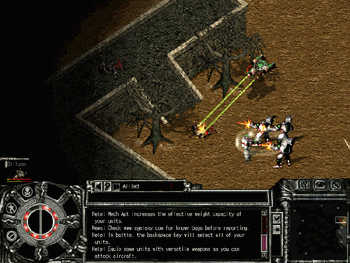 At the core of Shattered Galaxy is real-time tactical combat that can involve over 50 players in a single battle. Through battles, heroes earn resources, experience points, and lands for their faction. As soon as you have purchased and deployed your units, you are ready for
combat.
At the core of Shattered Galaxy is real-time tactical combat that can involve over 50 players in a single battle. Through battles, heroes earn resources, experience points, and lands for their faction. As soon as you have purchased and deployed your units, you are ready for
combat.
Combat is tactically complicated and can take some time to master. While this manual will provide an overview of important features and considerations related to combat, no words will substitute for actual experience. Experienced real-time strategy players will be familiar with many of these concepts, but some aspects of Shattered Galaxy warfare are atypical of the RTS genre. It is recommended that you reread this section after you have fought in a battle or two.
A. The Basics
This section outlines the general concepts employed in Shattered Galaxy combat.
- Unit Management
As opposed to other real-time strategy games, Shattered Galaxy combat does not rely on micro-management of dozens of units and buildings. Instead, you can command between 6 and 12 units,depending upon your hero's Tactics (see Section IV). All of your objectives during the battle must be accomplished by those units alone (unless you are working with other players who are your allies).
When the battle begins, the Recipient List will transform into the Command Wheel. The Command Wheel contains buttons for basic unit commands and will also have buttons for any special abilities of selected units.
a) Unit Selection
Selected units are those that will respond when you next issue a command (such as move or attack). Small representations of selected units will appear on the fringes of the Action Window so that you can easily monitor the status of selected units. You can select your units in several different ways.
- Left-click: Left-clicking on a unit selects it. When several units are selected, left-clicking on a unit's representation (on the edges of the Action Window) will select and center on only that unit.
- Dragging: Dragging a box around a group of units will select all of the units within that box that are under your control.
- Selecting all units: The hot key <"BACKSPACE"> selects all units.
- Control Groups: Press
-# to assign the currently selected units to a control group. Later press that # to select that group of units. Initially, each of your units belongs to its own control group, allowing you to select a unit by pressing its deployment number. <"shift">-# can be used to select multiple control groups. Pressing a # twice centers the action window on that control group.
b) Unit Inspection
Health, energy, and cargo (if applicable) information is shown on the edges of the Active Window for all selected units. Additionally, by moving your mouse over a friendly unit you will see its name, owner, health, and energy. Enemy units can only be inspected through a special ability afforded by some items.
c) Unit Movement
Right-clicking or using the (M)ove command and then left-clicking on a location on the Active Window or the Mini-map will give all selected units orders to move to that location. Units moving through these methods will ignore enemies and enemy fire and concentrate only on reaching the specified location.
d) Attacking
Stationary units will automatically open fire on enemy units that are within range. Additionally, they will move to attack out-of-range units that are within their line of sight.
Using the (A)ttack command will change the mouse arrow to cross-hairs. Subsequently left-clicking on a unit will order all selected units to attack that target. Using the 'Attack' command and left-clicking on the Active Window or the Mini-map will order the selected units to move to that location. Unlike the (M)ove command, the units will stop and fire upon any enemies that come within range. Note that with the (A)ttack command, friendly units can be fired upon if specifically targeted.
e) Stopping
The (S)top command will cause a unit to stop whatever action it was doing. This command is most useful for preventing units from wandering away from a location you wish to guard.
f) Special Abilities
To use a special ability, select the appropriate unit and then click on the desired ability on the Command Wheel. If the ability requires a target, such as the ability inspection, then the mouse arrow will change to cross-hairs and you must left-click on the target. Note that some abilities, such as radar require that the unit be installed first.
- Left-click: Left-clicking on a unit selects it. When several units are selected, left-clicking on a unit's representation (on the edges of the Action Window) will select and center on only that unit.
- Health
The most important consideration in battle is the health of your units. When a unit's health reaches zero, it is destroyed. A unit's health is indicated by the bottom of the bars shown when it is selected. The red portion of the bar shows the health that has been lost; the yellow portion shows the health remaining. Units operate at 100% performance until they are destroyed. Unit health is decreased by being attacked by enemies. Unit health can be restored through special abilities provided by certain items, such as a First-Aid Kit.
The color and size of the circle around the base of selected units reveals unit health at a glance. Furthermore, mouseover a friendly unit will show both its health and energy bars.
After a battle, units will remain damaged until repaired. You should pay careful attention to your unit's current health before heading into a combat. Units can be repaired at the Factory.
- Energy
Energy, represented by a blue/green bar above the health bar, is only slightly less critical than Health. When a unit's energy reaches zero, it is unable to move, fire, or use special abilities. Units that have run out of energy are not destroyed immediately, though they are very vulnerable to enemy attack.
Energy is spent through two primary mechanisms: passive requirements and active usage. Many systems, such as engines, computers, and some armor, have passive energy requirements. Every second they consume some small amount of energy. Therefore, even a stationary unit will generally find its energy reserves decreasing slowly.
Items such as weapons and many miscellaneous items have active energy requirements. Each time the weapon is fired or the item is used, energy reserves are drained. Unlike passive energy costs, active energy is not expended constantly. However, active energy costs tend to be quite high. For example, a unit with a powerful (and energy intensive weapon), such as a Maser, will find its energy depleted rapidly.
Fortunately, several methods of replenishing energy are available. First, all units are assumed to be fully recharged after any battle. Second, some items allow one unit to transfer energy to another. This ability is an excellent way to restore a unit that has run out of energy. Other means of restoration vary by energy type.
Solar power supplies regenerate energy constantly. Typically, solar powered units will lose energy while actively engaged in combat, but recover energy when only passive energy requirements must be met. Methane and battery powered units can refuel at specific locations on the battlefield (see Section V.C.3). Some batteries (primary cells as opposed to accumulators) cannot be recharged except by other units.
- Time
Because of the tremendous physiological impact of the telepathic drug Commune, heroes can only remain in combat for approximately 20 minutes. The red lights on the inside of the Command Wheel indicate how much time remains until your hero must disengage. The burden of victory is on the attacker; if time expires, the defender holds the province.
B. Objectives
Each battlefield contains several locations of tactical significance. Each type is outlined below.
-
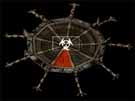 Points
of Contention
Points
of Contention
The Points of Contention (PoC) are the primary objectives on the battlefield. Once one side controls all PoCs, they achieve victory and the battle ends. The PoC appear as large circles on the ground divided into many segments, like a pizza. To capture a PoC, move any ground unit onto it. The PoC will light up, segment by segment. When the PoC has entirely lit up, your nation's symbol will appear on it, and you will have captured that PoC. Aerial units cannot capture PoC.
- Resource Deposits
Most battlefields will contain one or more resource deposits. While factions frown upon the plundering of faction-owned resources, a contested battlefield's resources can be exploited without detection.
To collect a resource during battle, simply move a unit equipped with a collection item (such as a Cargo Hold) over the resource to be collected. The resource will be visibly depleted on the map and your unit's cargo capacity bar will fill up. Each unit with a collection item can gather any combination of resources until it's cargo capacity has been reached.
After a battle, the victorious side will receive all collected resources (divided evenly among all the victorious heroes regardless of who actually collected them). If you lose the battle, you do not receive any of the resources you may have collected.
-
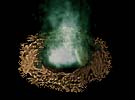
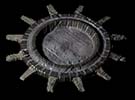 Refueling
Stations
Refueling
Stations
Energy plays a large role in most battles. If a unit runs out of energy, it is unable to move or fire. All battlefields will contain refueling stations - gas springs for methane reactors and rejuvenation pads for batteries. These stations have great tactical significance because a unit with the appropriate type of power supply can increase their energy by simply standing on a refueling station. For example, a Footman with a methane reactor can stand on gas springs to gain energy.
- Higher Ground
Most battlefields will contain areas of higher elevation, such as plateaus and the tops of buildings. Units on higher ground gain range and vision bonuses, making these useful areas to control. [Not fully implemented]
C. Logistics
The battlefields of Shattered Galaxy are dynamic. An enemy hero's forces may be outnumbered and hard pressed one minute and supported by a fresh brigade of Gryphons the next.
- Reinforcements
A hero may never send more of his units to reinforce himself during combat. However, other heroes are able to enter the fray at any time. The hero from any faction with the highest Tactics is the Field Commander of his faction's forces during that battle. Should a hero with higher Tactics than his faction's current Field Commander enter the battle, this new hero assumes the position of Field Commander.
If others heroes attempt to enter a contested province, the Field Commander must approve their access to the combat. The Field Commander's 'Check' button lights up when an ally requests permission to join the battle.
For example, hero A enters a province occupied by the enemy hero B. A battle ensues. Hero C, who belongs to the same faction as hero B, moves to enter the province and reinforce his ally. Hero B must okay hero C's offer of assistance. Hero D, who is an enemy of both heroes A and B, can, however, enter the province without permission; a three-way battle for the province then ensues.
The number of heroes that can participate in a battle is limited by the Field Commander's Tactics: 8 heroes plus 1 for every 7 points of Tactics the Field Commander has. Note that while defenders may begin a battle with more heroes than allowed by this restriction, additional heroes will be unable to bolster the defending forces if the tactics restriction is exceeded.
- Regiments
Each hero provides different strengths and weaknesses to a faction in battle. A great tactician can exploit both the strengths and the weaknesses of a hero's units, to develop the best militaristic philosophy available to his or her faction. The tactician in this case is the overlord. It is the overlord's privilege to assess the strengths and weaknesses of the hero's in his faction, and assemble them, under one general, into different squadrons, dependent on the needs of his or her faction at that given moment. In Shattered Galaxy, these squadrons are known as regiments. The overlord appoints a ruler to this regiment, entrusting this ruler with the responsibility of governing day-to-day militaristic affairs of that regiment. If an overlord is truly successful and deigning regiments and assigning rulers, he or she will have a vast array of regiments with strengths lying in different aspects of combats, and his armed forces will work as a well-oiled war machine. (see section VIII.C.1) - Retreat
A hero retreats his units by moving them to any of the portals (excluding subterranean caverns) on the battlefield. The 'Check' button will light up when a unit is capable of retreating. Clicking on the 'Check' will give you the option to retreat one of your units. You do not have to retreat all of your units. Retreated units cannot return to the same battle, but a hero who retreats with all of his units may be able to return to a large battle in progress. When one of your units retreats from a battle, any remaining units are restricted from retreating through different portals; your units cannot split up to reach different provinces. It is possible to retreat into an enemy territory, in which case another battle will immediately ensue before you have the opportunity to redeploy your forces.
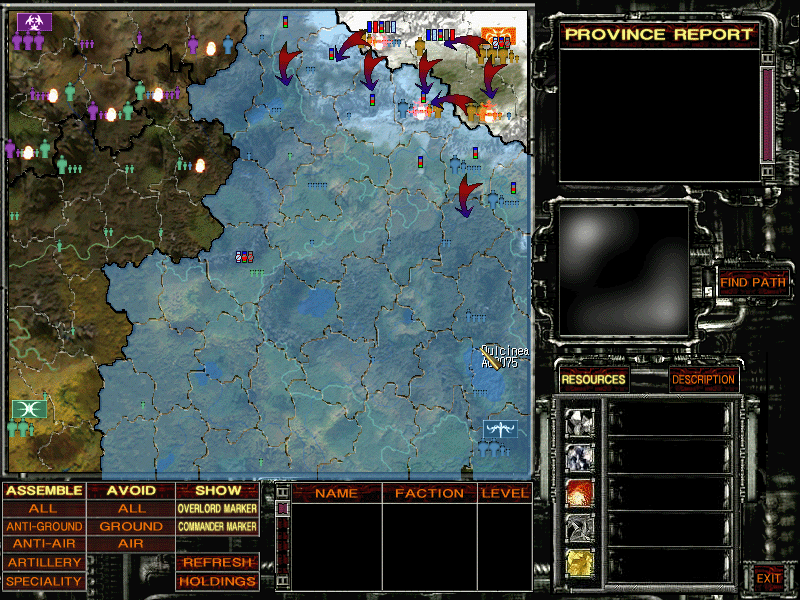 Strategic Map
Strategic Map
The Strategic Map, viewable either in Hero or Battle Mode through the F2 key (or the 'Eye' button), shows the real-time status of the planet your hero is on. A primary use of the Strategic Map is identification of good targets. It is also useful for assessing what enemy and allied reinforcements would be available for an attack.
All provinces are shown and faction markers indicate ownership. Press 'Grid' to color-code the provinces by owner. Unmarked/uncolored provinces are currently controlled by the aliens. Moving the mouse over a province shows that province's name and lights up the owning faction's territory as well as the territories of all of their allies.
Additionally, small humanoid icons show how many heroes are present in each province. Flames mark currently contested provinces.Clicking on a province will display additional information about it, including the mini-map. The amount of information received depends upon your faction's espionage rating and your hero's clout. To travel to a specific province, either click "Find Path" when the province is selected or right-click on your desired destination. Your hero will begin walking to the appropriate portals to follow the path shown on the map. If your hero reaches any hostile provinces, you will return to hero mode and be told about the pending battle. You can manually set your hero's path by holding shift and right-clicking each province through which you wish your hero to travel.. Note that right-clicking on your hero's faction capital, or pressing F8 in hero mode, will instantly teleport your hero to the safety of his capital.
D. Spoils of War
Spoils of War
Initially, it is through your battles that your hero and his position in the galaxy will be defined. Combat yields many rewards for the victorious. Except as noted, spoils are divided evenly among the members (units or heroes depending upon the spoil in question) of the winning side. If you disconnect from a battle, whether intentionally or not, you suffer a loss as if you had been defeated in battle.
- Experience
All units of the winning side gain experience points based upon the experience of foes defeated and the value of the province in which the battle occurred. Even destroyed units earn some experience, though much less than those units that survived. Higher level units earn a greater share of the experience than lower level compatriots.
The units of the losing side lose approximately 1% from their experience. The winners split total experience points relative to that lost by the losers.
Additionally, destroyed units lose approximately 1% of their experience. Half of this experience is awarded to the unit that destroyed them, the other half is divided among the enemy units if the enemy is indeed victorious. Because of this experience award for destroying units, it is possible to lose a battle and still have some units advance. Remember that because experience awards are based upon your opponents' units, it is also possible to win a battle and/or destroy many enemy units and gain very little experience.
To reward bravery, several modifiers might apply to the gained experience:
- Field Commander: The Field Commander gains a +10% experience point bonus.
- No Guts, No Glory: If the attacker wins the battle, the attacking hero who initiated the battle, if he survived the entire battle, gains a 10% experience point bonus.
- Relative Difficulty: If the sum of unit levels of the winning side is greater than the sum of unit levels of the losing side, the winners' experience point gains are reduced proportionately. For example, if you defeat someone half your strength, you get only four times the experience they lost instead of eight times.
- Time Involved: Heroes who arrive late to a battle receive reduced, or even zero experience. This policy is to encourage heroes to earn their advancement.
Whenever a unit achieves a new level, the owning hero is awarded experience points, in that unit's division, equal to the level the unit reached. If the unit's new level is less than the hero's level, then the hero receives much less experience (the unit's new level minus half of the hero's level) for the unit's achievement. If the unit's new level is less than half of the hero's level, then the hero will receive no experience.
- Money and Resources
Factional governments reward each victorious hero with a stipend proportional to the value of the province to the faction and the resources it will provide for the faction's coffers. Note that unlike experience rewards, this stipend is awarded to each winning hero instead of being divided among them. Beyond this official award, factional leaders frown upon their members withdrawing resources from factional lands. In the chaos of battle, however, such resource gathering is overlooked and any resources gathered by victorious units during the course of the battle are divided among the winning heroes.
- Record and Prestige
All battle participants gain one win or one loss, as appropriate. Additionally, the winners gain prestige and the prestige of the defeated suffers. The amount of prestige won/lost is based upon the prestige of your opponent. For example, a very prestigious (and presumably powerful) hero gains little, if any, prestige for defeating an undecorated opponent.
- Territory
The winning faction gains control of the province in which the battle occurred. If multiple allied factions comprise the winning team, the first faction to attack the province gains the territory. The controlling faction extracts tribute (money and resources) from each province and distributes this wealth (after deducting taxes) to all of its members every 10 minutes of real time. Note that heroes who have not been actively fighting against other factions receive a smaller portion of their faction's tribute. Additionally, capturing provinces can yield strategic advantages (or weaknesses). - Territory
E. Aliens and Sims
The preceding sections about combat have concentrated on player versus player combat for provinces. Battles against aliens (with and/or against other players) and simulated battles are also possible.
- Aliens
The aliens are everywhere. Primarily concerned with research directly applicable to warfare, scientists have largely left the aliens unstudied. Different geographical regions of Morgana Prime are home to different types of aliens. To even the stupidest cyborg, however, it is apparent that, despite the great variety of alien lifeforms, they are all related in some ominous way.
A seemingly endless supply of aliens pours from their subterranean homes to infest the provinces. Any faction owned province will be retaken by the aliens unless constantly inhabited. Provincial battles against aliens are very similar to those against other players except prestige is neither gained nor lost.
Also, keep in mind that for reasons only their dark minds can fathom, the aliens respond strongly and proportionately to threats. Should another hero join your battle against the aliens, more of the foul creatures will rise from their subterranean homes to deal with the greater threat.
The quantity and difficulty of aliens you face increase with distance from your own capital and proximity to enemy capitals. Battles against the aliens in their subterranean lairs tend to be more difficult than surface battles. Often, aliens not seen above ground lurk in these dank lairs. Additionally, the underground regions cannot be conquered.
- Simulated Battles
Combat in the sims is excellent for testing new unit designs and strategies or for analyzing an unfamiliar province before an attack. To participate in a simulated battle, simply go to the sim (with units deployed) and click on the province to use as the simulated terrain. Only one instance of a simulated combat for a specific province is possible at a time throughout the entire galaxy. Heroes do not need to enter the same sim to fight in the same simulated battle.
The first hero to enter a province in the sim is the leader of that simulated combat and can ban disruptive persons as he sees fit. All heroes must then walk to either the blue (defender) or red (attacker) areas of the simulated map. The leader then begins the combat. Nothing is won or lost in simulated combat and, because simulated units are used, destroyed or damaged units emerge with whatever health they had when they entered the sim.
- Combat Training Battles
Battles in the CTF are designed to let heroes experiment with different chassis types without having to buy them. Instead of using his or her own units, several pre-made units of a variety of chassis types are provided. Heroes are even allowed to experiment with some chassis types they may not be able to purchase at their Influence (level + clout/2). Also, unlike in the sim, CTF combat is performed alone and against computer-controlled units.